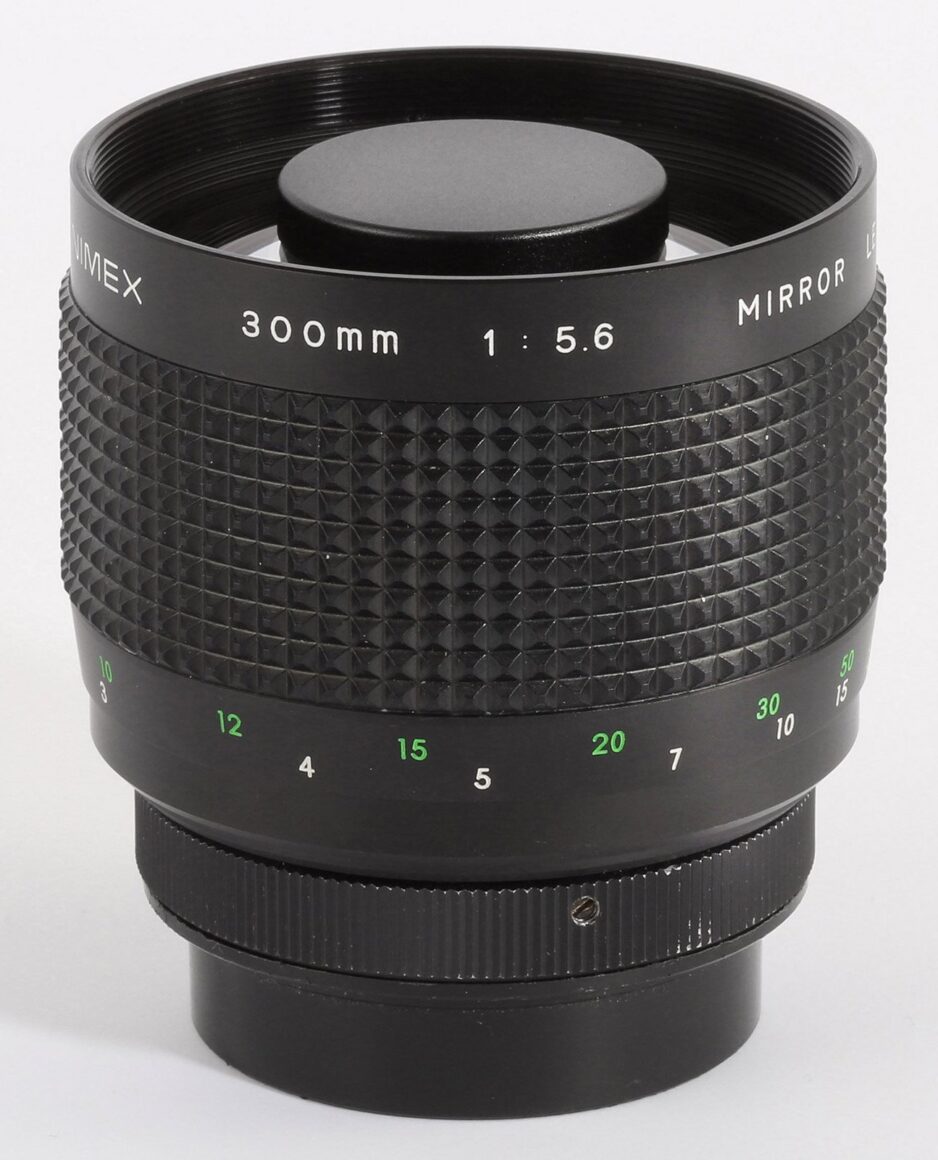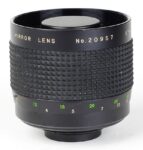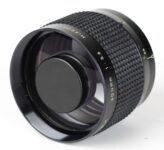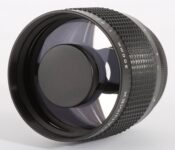Hanimex 300mm F/5.6 Mirror
aka Admiral 300mm F/5.6 Mirror
aka Cambron 300mm F/5.6 Mirror
aka Chinon 300mm F/5.6 Mirror
aka CPC Phase 2 300mm F/5.6 Mirror
aka Marumi 300mm F/5.6 Mirror
aka Ohnar 300mm F/5.6 Mirror
aka Optomax 300mm F/5.6 Mirror
aka Quantaray 300mm F/5.6 Mirror
aka Rokunar 300mm F/5.6 Reflex
aka Super Danubia 300mm F/5.6 Mirror
aka Super Travenon 300mm F/5.6 Mirror
aka Super-Paragon 300mm F/5.6 Mirror
aka Toyo Optics 300mm F/5.6 Mirror
Super telephoto prime lens • Film era • Discontinued
Features highlight


Specification
| Production details: | |
| Announced: | <No data> |
| Production status: | ● Discontinued |
| Original name: | HANIMEX 300mm 1:5.6 MIRROR LENS |
| System: | - |
| Optical design: | |
| Focal length: | 300mm |
| Speed: | F/5.6 |
| Maximum format: | 35mm full frame |
| Mount and Flange focal distance: | Interchangeable mount (T) |
| Diagonal angle of view: | 8.2° (35mm full frame) |
| Lens construction: | 8 elements in 5 groups |
| Diaphragm mechanism: | |
| Diaphragm type: | Fixed |
| Aperture control: | None |
| Focusing: | |
| Closest focusing distance: | 2.5m |
| Magnification ratio: | <No data> |
| Focusing modes: | Manual focus only |
| Manual focus control: | Focusing ring |
| Physical characteristics: | |
| Weight: | 300g |
| Maximum diameter x Length: | ⌀70×63mm |
| Accessories: | |
| Filters: | Screw-type 67mm |
| Rear screw-type 37mm | |
| Lens hood: | Screw-type round |
| Teleconverters: | <No data> |
| Source of data: | |
| HANIMEX. Objectifs traites multicouches booklet. | |
Manufacturer description #1
Quantaray ad from the Popular Photography magazine (May 1981):
Quantaray 300mm f/5.6 Compact Catadioptric Lens
Tomorrows Technology in Telephoto for Todays Photography
The Quantaray 300mm f/5.6 is an ultra compact, Catadioptric (mirror) telephoto lens which can give your photography that exciting compressed perspective look. Extremely compact and lightweight, this 300mm can be carried and used almost anytime, anywhere. This amazing lens comes complete with neutral density filters to control exposure.
The 300mm Compact Catadioptric lens - it takes your photography across distances at the speed of light.
Min. Focus: 2.5 meter
Filter Size: 34mm rear, 67mm front
Dimensions: 70mm x 66mm
Weight: 260(g)
Manufacturer description #2
Quantaray ad from the Popular Photography magazine (August 1982):
The Quantaray Catadioptric (mirror) Lenses are the telephotos for the photographer who demands an extremely compact and lightweight lens for field work. These Quantaray Lenses produce extremely sharp images and each comes with neutral density filters so exposure may be controlled through light levels as well, as shutter speeds.
300mm Technical Specifications: Length: 2.125"; Diameter: 2.63"; Aperture: f/5.6 (2xND/4xND); Min. Focus: 2.5 Meter; Weight: 260 g.
T Mount required for 300 and 500.
From the Exakta Equipment Information Service (No. 481)
Ultra Compact 300mm F5.6 Cambron Mirror Telephoto Lens
"Are you kidding?" That's what everybody asked when we said that our new 300mm Lens fits into the above small space. But we are not kidding. It is true! You know about the current trend to make lenses smaller, "more compact" as they call it. But shrinking a lens to just 20% of its "rightful" size....? They would have to chop off 80% of its length! Well, they did it! The result: our new 300mm Telephoto Lens.
Originally, a 300mm lens was 300mm long; no ifs, ands, or buts. Then they invented "telephoto" lenses which had negative elements in them, shortening the length of a 300mm lens to about 250mm, maybe 230mm. Next came "Mirror" Lenses which made lenses look like coffee cans. What they lost in length, they gained in width (diameter) and a 300mm lens was still some 150mm long. But now we bring you the ultimate in shrinking, both in length and in diameter, a 300 mm Lens just 60mm long (that's less than 2 1/2 inches!) and a mere 2 3/4 inches in diameter!!!
Actually, the path of the light rays is reflected back and forth inside the barrel by mirrors like the ones in the giant telescopes that probe the skies for galaxies in the remote regions of the Universe, millions of lightyears from this little planet.
Mirror Lenses have several advantages over ordinary conventional lenses: the light rays do not have to pass through thick glass where they pick up all kinds of detrimental characteristics and there is no refraction such as happens at the diaphragm of conventional lenses. The image of a mirror lens is "clear" which translates into "sharp" and "color-true". And that is what we want, isn't it?
But the bitterest enemy of sharp telephoto pictures is camera shake. It is very difficult to hold a large, heavy lens rock steady. This problem is completely eliminated in our new 300mm lens. Being barely larger than your normal 50mm lens and adding hardly any weight to the camera (mirrors are extremely light compared to thick lenses of heavy glass!), our new 300mm Lens handles just like your normal 50mm lens yet it gives six times the linear magnification (which is equivalent to 36 times the area magnification, think of it!!!)
To sum up: 300mm F5.6 Cambron Compact Mirror Telephoto Lens, light in weight, tiny in size, a giant in performance.
From the Modern Photography magazine
The first of this month's duo is a 300mm f/5.6 Cambron which is an incredibly small 2 9/16-in. long (with necessary T-thread adapter), 2 3/4 in. in diameter and weighs but 9 oz. It focuses to 8 ft., comes with a non-standard rear screw-off skylight filter and case. The front is threaded to accept 67mm filters but the prominent secondary mirror backing at the front might make screwing in most filters a might difficult.
From the Popular Photography magazine (May 1982)
The CPC Phase 2 line was unusual in introducing no zoom lenses. What they did show included a compact 300-mm f/5.6 mirror telephoto, which is sold as part of a kit that includes a 2X matched multiplier (to create a 600mm f/11 combo), 34-mm neutral-density filters (necessary because catadioptric lenses don't have diaphragms), shade, and case. Minimum focus, with or without the multiplier, is 2.5m. Price for the kit is $350; a T-mount lens adapter os $13.50 extra.
From the British Journal of Photography (9 April 1982)
CPC calls its lens range the 'Phase 2' which is evidently a house-created quality tag similar to Vivitar's 'Series 1'. Vivitar got away with that approach because a decade ago it was fairly new. Today these labels are beginning to proliferate - 'Advanced Technology' AT-X by Tokina, SP - 'Superior Performance' by Tamron, not to mention the 'High-Fi', 'T-Star' (T*) of Zeiss etc - so 'Phase 2' is not particularly memorable.
LENS-DB: As for the "CPC", it means "Combined Products Corporation" (another junk brand name).
Typical characteristics of mirror (reflex) lenses
- Catadioptric system consisting of curved mirrors and optical glass;
- Much shorter, lighter and less expensive designs than conventional super telephoto lenses;
- Outstanding correction of chromatic aberrations;
- Since the aperture is fixed, neutral density filters are used to obtain a smaller aperture;
- Doughnut-shaped out-of-focus highlights.
From the editor
The same lens was sold under the following names:
- ADMIRAL 300mm 1:5.6 MIRROR LENS
- CAMBRON 300mm 1:5.6 MIRROR LENS
- CHINON MIRROR LENS 300mm 1:5.6
- CPC PHASE 2 300mm 1:5.6 MIRROR LENS
- SUPER DANUBIA 300mm 1:5.6 MIRROR LENS
- MARUMI 300mm 1:5.6 MIRROR LENS
- OHNAR 300mm 1:5.6 MIRROR LENS
- OPTOMAX 300mm 1:5.6 MIRROR LENS
- QUANTARAY 300mm 1:5.6 MIRROR LENS
- ROKUNAR 1:5.6 f=300mm REFLEX LENS
- SUPER-PARAGON 300mm 1:5.6 MIRROR LENS
- TOYO OPTICS 300mm 1:5.6 MIRROR LENS
- SUPER TRAVENON 300mm 1:5.6 MIRROR LENS
The original manufacturer is unknown (it was not Hanimex, of course).
Lenses with similar focal length
Sorted by manufacturer name
| ■Interchangeable mount (7) | |||||||||
| Makina Makinon 300mm F/5.6 Reflex MC [T] | -- | 8 - 6 | 1.20m | ● | |||||
| Panagor 300mm F/5.6 Reflex PMC [T] | -- | 8 - 5 | 2.50m | ⌀67 | 1981 ● | ||||
| Spiratone Minitel-S 300mm F/5.6 Mirror Plura-Coat [T] aka Osawa 300mm F/5.6 Reflex MC aka Seikanon 300mm F/5.6 Reflex MC aka Soligor C/D 300mm F/5.6 Mirror | -- | 6 - 4 | 2.50m | ⌀72 | 1982 ● | ||||
| Spiratone Minitel-T 300mm F/5.6 Mirror Plura-Coat [T] aka Elicar 300mm F/5.6 Reflex MC | -- | ? - ? | 2.50m | ⌀67 | ● | ||||
| Kalimar 300mm F/5.6 Mirror [T] | -- | 7 - 4 | 3.00m | ⌀62 | ● | ||||
| Weltblick 300mm F/6.3 Mirror [T] aka Hanimex 300mm F/6.3 Mirror | -- | ? - ? | 2.50m | ● | |||||
| Celestron 300mm F/5.6 Mirror [T] | -- | ? - ? | 2.50m | ⌀67 | 1981 ● | ||||
| ■Canon FD mount (1) | |||||||||
| Makina Makinon 300mm F/5.6 Reflex MC | -- | 8 - 6 | 1.20m | 1980 ● | |||||
| ■Contax/Yashica mount (1) | |||||||||
| Makina Makinon 300mm F/5.6 Reflex MC | -- | 8 - 6 | 1.20m | 1980 ● | |||||
| ■Konica AR mount (1) | |||||||||
| Makina Makinon 300mm F/5.6 Reflex MC | -- | 8 - 6 | 1.20m | 1980 ● | |||||
| ■M42 mount (3) | |||||||||
| Makina Makinon 300mm F/5.6 Reflex MC | -- | 8 - 6 | 1.20m | 1980 ● | |||||
| Rubinar 300mm F/4.5 Mirror MC Macro | -- | ? - ? | 1.70m | ⌀77 | ● | ||||
| ZM-7K 300mm F/5.6 MC | -- | ? - ? | 1.70m | ⌀67 | ● | ||||
| ■Minolta SR mount (1) | |||||||||
| Makina Makinon 300mm F/5.6 Reflex MC | -- | 8 - 6 | 1.20m | 1980 ● | |||||
| ■Nikon F mount (2) | |||||||||
| Makina Makinon 300mm F/5.6 Reflex MC | -- | 8 - 6 | 1.20m | 1980 ● | |||||
| Samyang Reflex 300mm F/6.3 CS UMC • APS-C aka Bower Reflex 300mm F/6.3 CS UMC aka Rokinon Reflex 300mm F/6.3 CS UMC aka Walimex Pro Reflex 300mm F/6.3 CS UMC | -- | 8 - 8 | 1.10m | ⌀58 | 2014 ● | ||||
| ■Olympus OM mount (1) | |||||||||
| Makina Makinon 300mm F/5.6 Reflex MC | -- | 8 - 6 | 1.20m | 1980 ● | |||||
| ■Pentax K mount (2) | |||||||||
| Makina Makinon 300mm F/5.6 Reflex MC | -- | 8 - 6 | 1.20m | 1980 ● | |||||
| Rubinar 300mm F/4.5 Mirror MC Macro | -- | ? - ? | 1.70m | ⌀77 | ● | ||||





